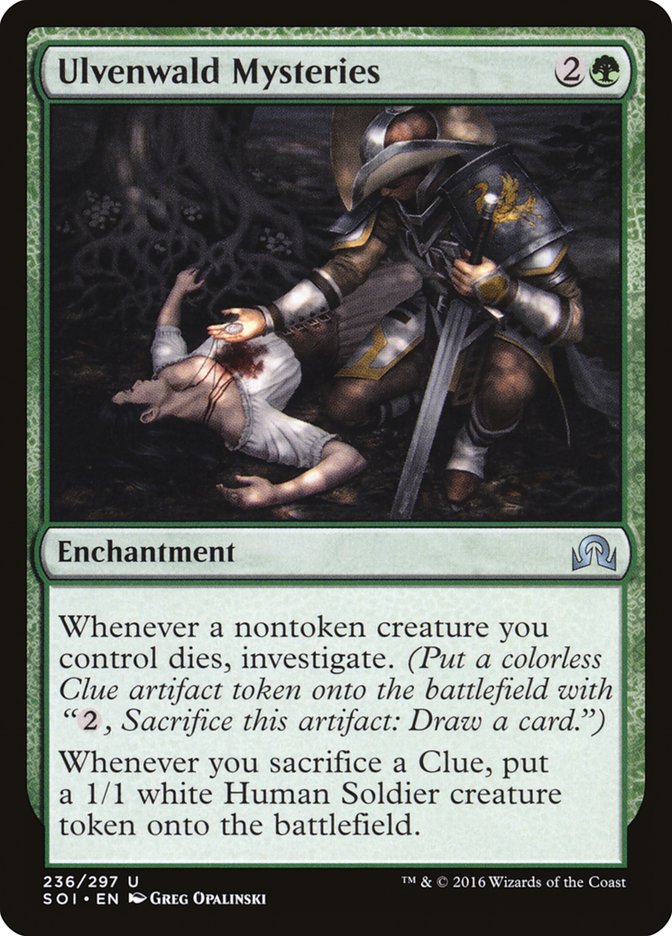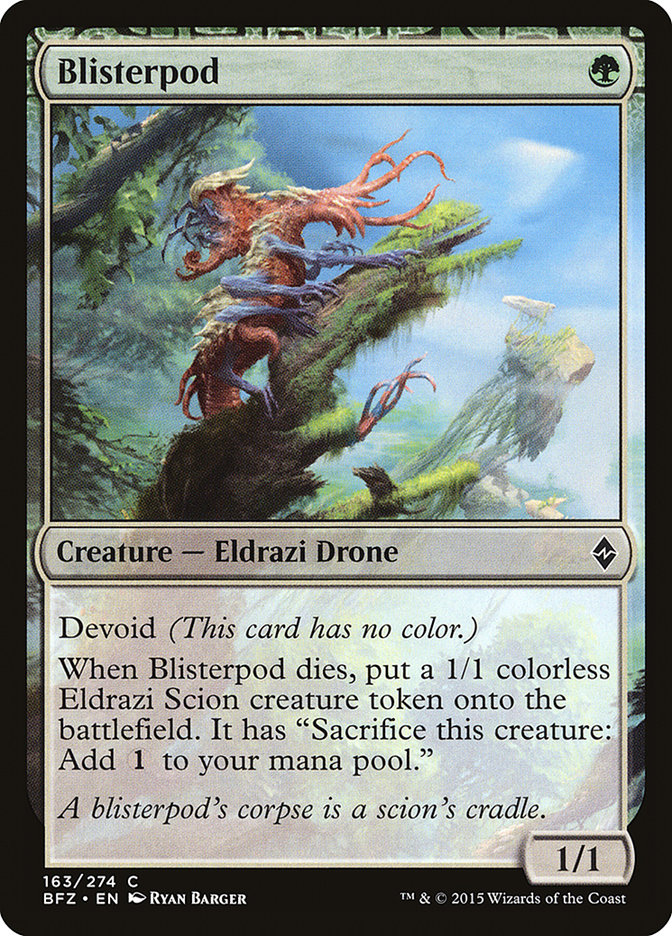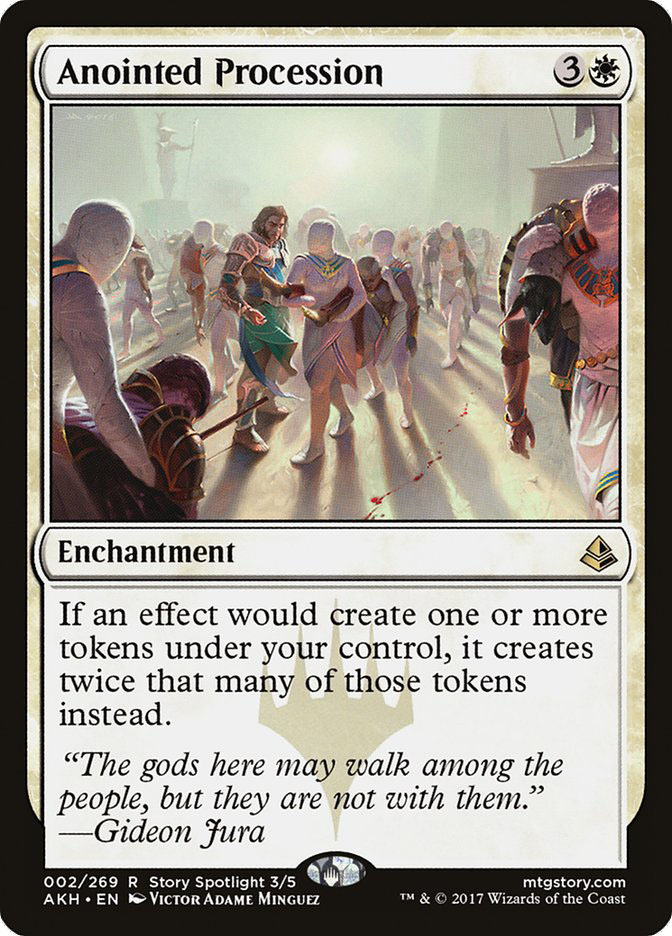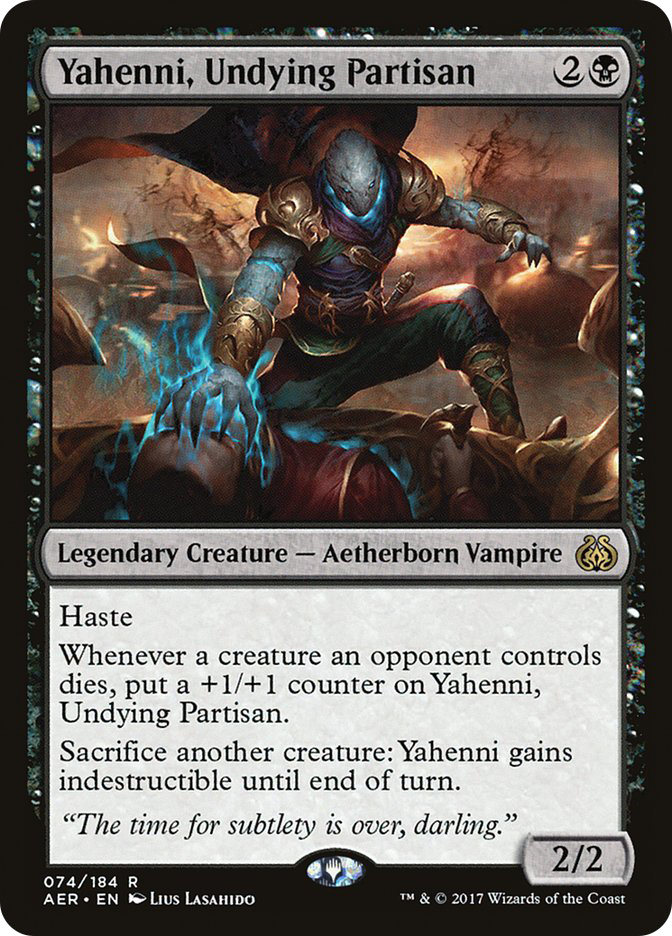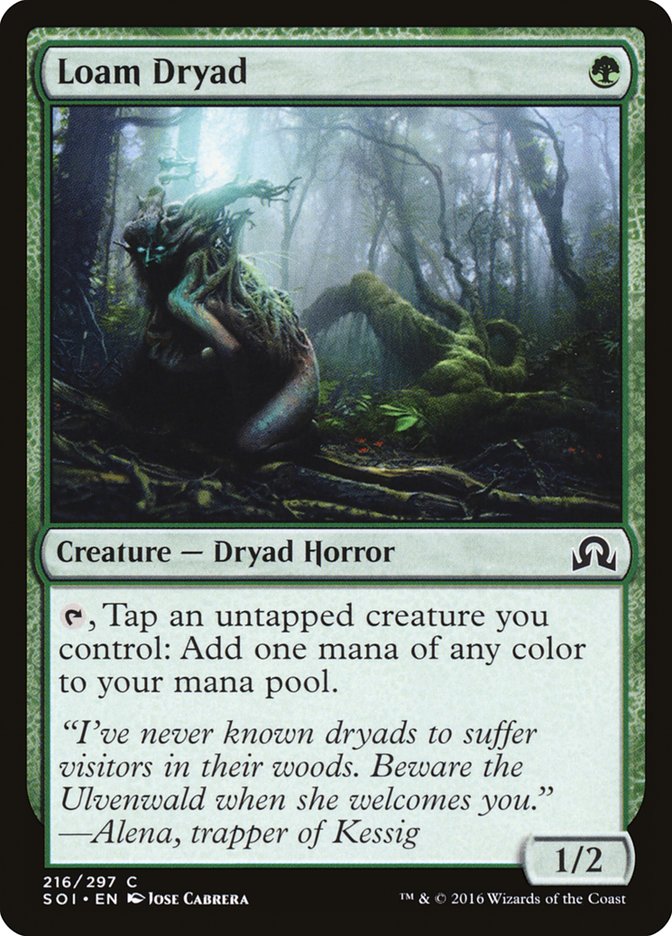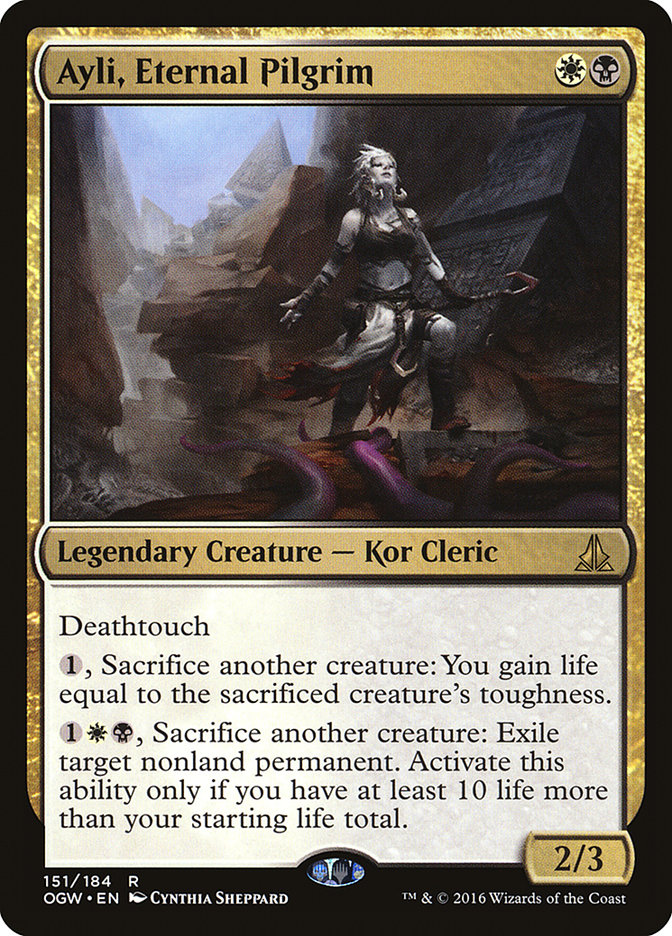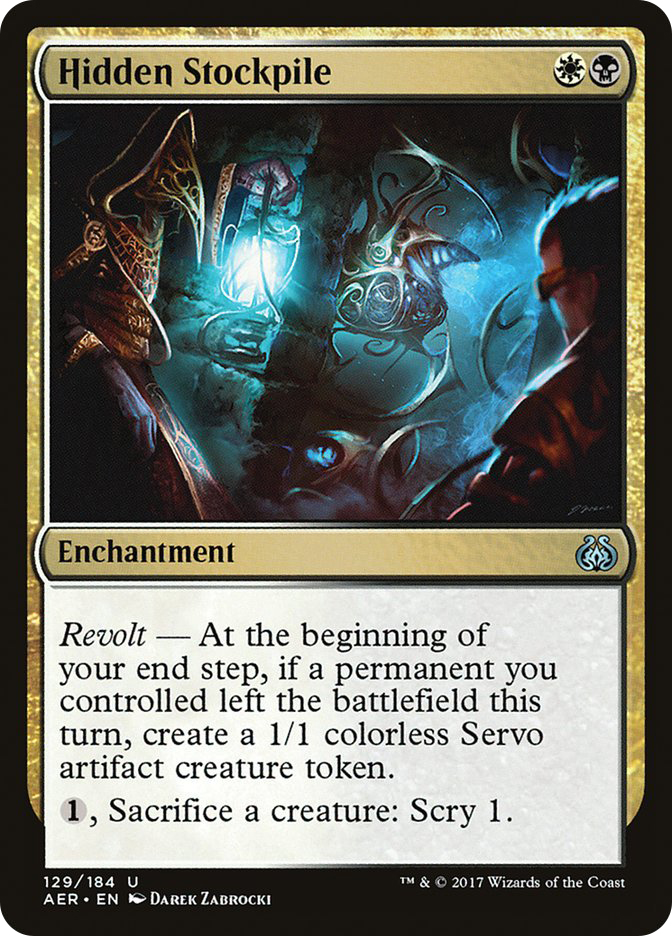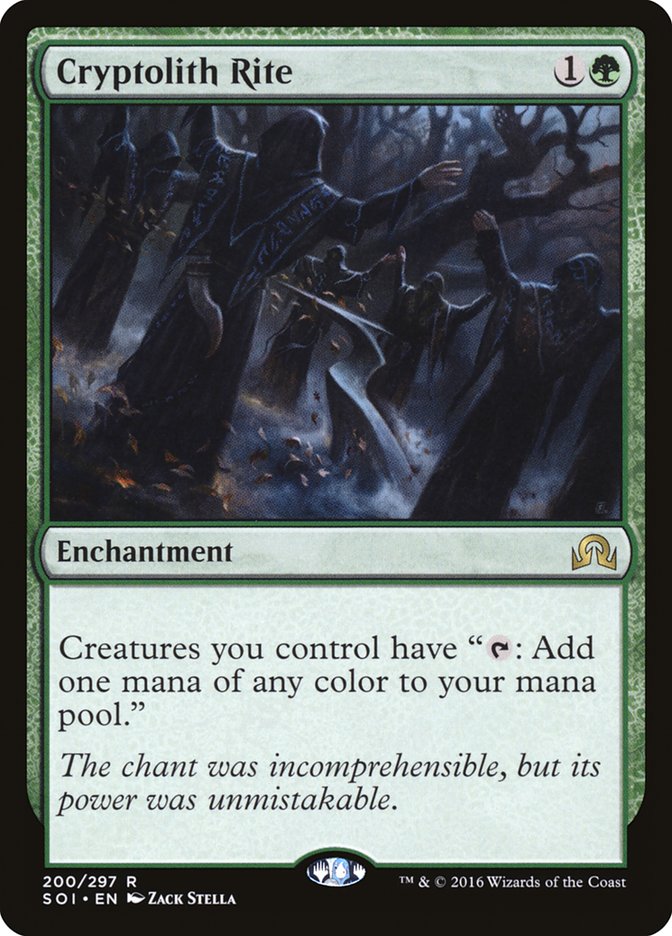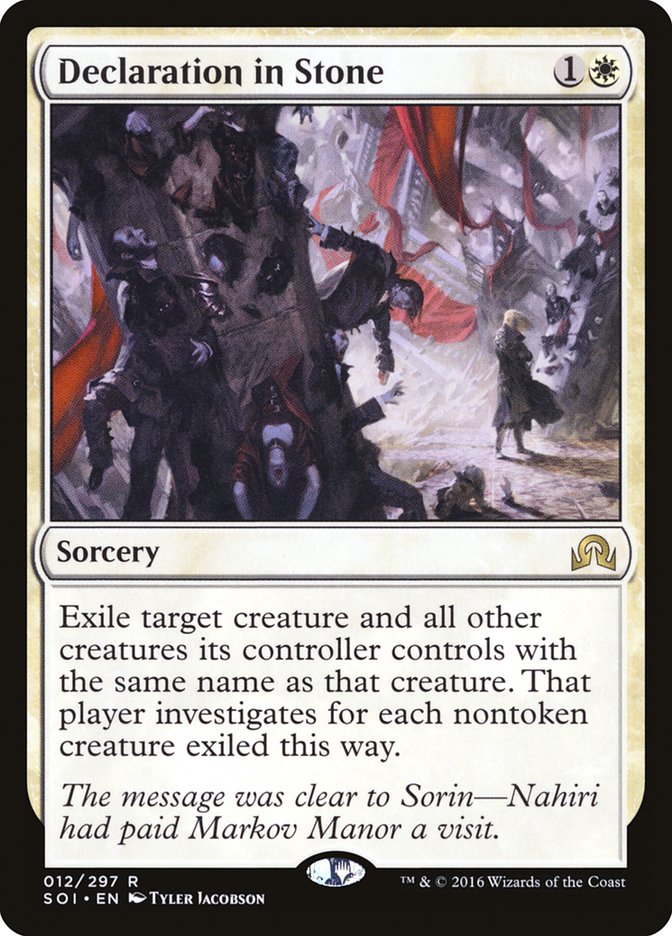#GPOmaha preview pic.twitter.com/Z55OHrAdBY
— Sam Black (@SamuelHBlack) May 28, 2017
I tweeted a screenshot of the last game in a recent League I played where I didn’t drop a game with my updated Abzan Tokens list, and a lot of people have asked me for the new list and my thoughts on the deck or other cards, so for anyone who’s looking for something offbeat, fun, and powerful for a GP this weekend, let me recommend Abzan Tokens, a deck that I genuinely think is well-positioned in Standard at the moment, in addition to being some of the most fun I’ve ever had playing Standard in a format where a lot of people are turned off by the popular decks.
The basic idea is the same as it was when I played the archetype at #PTAKH, but the execution has improved considerably.
Let’s start with my current list:
Creatures (18)
- 4 Catacomb Sifter
- 4 Blisterpod
- 4 Thraben Inspector
- 1 Loam Dryad
- 1 Yahenni, Undying Partisan
- 4 Anointer Priest
Planeswalkers (2)
Lands (25)
Spells (15)
Sideboard

The biggest change to this deck from my PT deck is that I’ve removed Fatal Push from the maindeck and added Ulvenwald Mysteries. Going into the Pro Tour, I was primarily concerned with beating Mardu and Zombies as often as possible, and I felt like Fatal Push was required to beat Cryptbreaker and Heart of Kiran. Now that the format has shifted toward Aetherworks Marvel and U/R Control, Fatal Push is a pretty huge liability in Game 1. Moreover, the deck is all about synergies, and the more I can play into the theme, the better every other card becomes.
Ulvenwald Mysteries is a card I’ve been interested in for a long time. I liked it a lot in my testing for PT Shadows over Innistrad when I played G/B Cryptolith Rite. We ultimately moved it to the sideboard, and my teammates didn’t like it because it ran face-first into Kalitas, Traitor of Ghet, but no one plays Kalitas these days, so that’s not a concern, and the card is remarkably powerful, especially with Cryptolith Rite.
Ulvenwald Mysteries gets pretty crazy when you have two on the battlefield, since you ultimately get four tokens whenever one of your nontoken creatures dies (while drawing two cards), which is great for buying time and finding more creatures to keep the chain going. Anointed Procession has the exact same effect as a second Ulvenwald Mysteries, so the deck is very good at getting into this spot.
The other massive upgrade to the deck is replacing Sacred Cat with Blisterpod. I really hurt my chances at the PT by getting locked into thinking of this as a W/B Deck that was splashing green and not thinking more about a green base with Cryptolith Rite and Blisterpod. It’s tricky because Forest is a really bad card when trying to cast Hidden Stockpile, but Blisterpod is so much better than Sacred Cat, it’s kind of disgusting.
Rather than costing a mana to get the token, the token can give you a mana. Further, if you have a Blisterpod or two and an Anointed Procession, if your opponent plays a sweeper, you get creatures immediately that can keep the pressure on. Critically, this means that if your opponent uses Chandra, Flamecaller, you get creatures that can immediately attack and possibly finish off the planeswalker.
Additionally, if you block a creature early with Blisterpod, you potentially get to cast Anointed Procession a turn early, rather than gaining a life and having access to another chump blocker. That’s a completely different world, and sometimes your opponent won’t even want to attack into a Blisterpod that can chump block in the early-game.
Moreover, once you’re really “going off” with Ulvenwald Mysteries or multiple Anointed Processions, Blisterpod actually becomes your best draw, netting you every kind of resource. Consider the example where you have one Ulvenwald Mysteries, one Hidden Stockpile, and two Anointed Processions:
You draw Blisterpod and cast it.
You spend a mana to sacrifice it to Hidden Stockpile.
You get to scry 1, make four Eldrazi Scions, and four Clues.
Each of those Clues gives you four Human Soldiers, and the Eldrazi Scions give you the mana to sacrifice two of them immediately, or you can use the mana to do other things, but that Blisterpod had a floor of “1G: Draw two cards, scry 1, create eight Human Soldiers and two Clue tokens.”
Not a bad card, and things get really crazy if you have more of anything, including Catacomb Sifter, which adds five scry triggers that order wherever you want, or Anointer Priest, which would give you twelve life in that scenario, and these things stack favorably with each other.
The other additions to the deck have been Yahenni, Undying Partisan and Loam Dryad. Yahenni had performed fairly well in testing, but I decided that I just didn’t care enough about a lone attacker and I wanted to focus more on synergy. That’s still largely true, and I’m not sure if Yahenni is right, but I want to reliably be able to sacrifice my nontoken creatures when I have Ulvenwald Mysteries, and I’m not sure that just four copies of Hidden Stockpile is enough.
It might be. It’s also possible that Ayli, Eternal Pilgrim is a better option, since the exile effect is a great way to deal with Ulamog, as you will often be above 30 life, but I like that Yahenni is a lot more likely to stay on the battlefield so that it can actually let me sacrifice my creatures when I need to, and it’s also nice to have a way to do it without spending mana.
I tried four Loam Dryads, but it just added too many low-impact cards that don’t ultimately contribute to my synergies, so I cut them all. I added one back because I decided things were a little too clunky, and it overperformed, so I’m sticking with it for now, but it’s certainly one of the first cards to go when I’m looking for space in sideboarding.
The lands had to change around to account for the extra green spells, of course, and I’m still not 100% certain about the right mix. My current configuration gives me sixteen green sources, fourteen black sources, and fifteen white sources, counting Evolving Wilds as all of them. Cryptolith Rite and Loam Dryad kind of function as additional white or black sources, but sometimes I’ll need white or black mana to cast another creature to get mana off them. Unless I have Blisterpod and Loam Dryad or Cryptolith Rite, I can’t cast any of my other spells off just green mana.
I feel good about these numbers, but the deck has a lot of lands that enter the battlefield tapped at the moment, so it’s possible that I just want more basics. The biggest problem is that basic Forest is a really bad card in a deck with Hidden Stockpile, but that might not be a dealbreaker. I’m going to experiment with cutting Hissing Quagmire for a Forest and Fortified Village for a Plains, which would put me at fifteen green, fifteen white, thirteen black, which I think should be workable, but I’m including the last manabase I’ve actually had success with as the default.
My sideboard has changed considerably as well. I think Grasp of Darkness was a big mistake. I thought that I wanted extra removal against Mardu and Zombies, but in practice, that diluted my deck too much, and I never actually want that many removal spells. That made it easy to just replace those with the Fatal Pushes that came out of my maindeck. Without all those BB requirements, I no longer feel like I need a Swamp in my sideboard. Lost Legacy will be a little hard to cast sometimes, but I think that’s acceptable. It’s possible that I only want two, and that I want to accept that sometimes Ulamog, the Ceaseless Hunger will get cast and I’ll exile it and accept that the trigger happened.
Declaration in Stone has been great. It’s the best removal spell against Zombies because it lets me sweep their tokens or exile things that come back, and I don’t mind giving them the Clue tokens because the game reaches the point where nothing they do matters, often before they can afford to cash them in. It also exiles Ulamog or an army of Thopter tokens against Aetherworks Marvel, and it’s nice that I can sometimes cast it on myself; if I have two Thraben Inspectors and an Anointed Procession, I can just use it to make four Clues, which is sometimes what you need to do, especially if you also have Ulvenwald Mysteries on the battlefield.
Tireless Tracker is experimental. It’s obviously great with Ulvenwald Mysteries, and it’s a good way to punish people who figure out that creature removal is generally bad against me. On the other hand, it’s kind of like Yahenni, Undying Partisan, in that it’s doing its own thing a little more than it’s contributing to the strength of my other cards, and I’m not sure where it’s right to become less focused in that way.
The rest of my sideboard just the cards that had previously been working for me.
So that’s the deck. Now let’s get to the matchup and sideboarding guidelines, which I imagine are what you were really still reading for.
Aetherworks Marvel
If you think that they have inevitability and try to function as a beatdown deck that’s looking to kill them before they Ulamog you, you’re probably going to hate the matchup. Fortunately, that’s not really what’s going on.
Game 1 can be tough, but your basic plan is just to get as many objects onto the battlefield as possible. Don’t try to maximize damage per turn; just try to maximize your development. Your goal is to have enough different cards on the battlefield that matter that you can take an Ulamog trigger and keep doing good things. You only have one Anguished Unmaking to answer Ulamog in the maindeck, so you want to be aggressively digging for it from the beginning of the game. If you can’t find it, you’ll have to be able to kill them before Ulamog decks you, which isn’t always easy. Obviously, if they Ulamog you on turn 4-5, you lose, just like you would if you were playing any other deck.
After sideboarding, things improve a lot. You get Lost Legacy and answers to Aetherworks Marvel or Ulamog if they manage to cast it before you can Lost Legacy, and their Plan B isn’t really competitive with your engine.
In:
Out:
I’m not completely sure you want the Tireless Trackers here, and I’m not sure about exactly what should be cut. You don’t need a lot of Anointer Priests because they aren’t pressuring you quickly, but you do want to leave two or three of them in your deck so that you don’t have to worry about Thopters and their other pressure. Blisterpod is low-impact and the game is all about building a powerful engine, so it can go, but you need to keep early plays for Cryptolith Rite, especially since getting BB for Lost Legacy can be hard without it. Gideon isn’t bad, but you’re trying to go big and it’s a little too midrange. Yahenni is the wrong kind of pressure, though it does happen to match up fairly well against Chandra. I think Tireless Tracker’s better, though.
U/R Control
I think this matchup’s favorable, but it’s weird. It often feels like you can’t lose. You get an engine established and their answers match up terribly against your random nonsense. They can draw as many cards as they want and it just doesn’t matter. Other times, they counter your engine pieces, take some hits from your creatures, cast Sweltering Suns, cast a Gearhulk, kill you, and everything feels hopeless.
Like I said, it’s a weird matchup.
After sideboarding, I think things improve a lot for them, because they get Dragonmaster Outcast and Thing in the Ice, so they don’t have to try to answer everything you do; they can just play one of those and slow you down enough to win. Because of this, Anguished Unmaking is very important, and you probably even want some Fatal Pushes, but it’s tricky, because if your hand is too reactive, they’ll easily beat you with card draw.
In:
Out:
I haven’t actually sideboarded this way before, but I think it looks right. Catacomb Sifter is too easily dealt with by Sweltering Suns, and scrying isn’t actually that important because drawing lands is fine because Westvale Abbey is often a big part of your plan. As with Aetherworks Marvel, they’re not really pressuring your life total, so Anointer Priest is a lower priority. Dusk // Dawn is speculative, but I’m thinking Dusk is a reasonable answer to their threats and Dawn is great in grindy games, but it is slow, situational, and hard to resolve, so it could be very wrong. Note that this exact sideboarding strategy is untested and take it as fairly flexible.
Mardu
You’re hoping to slow them down enough to get established with Anointer Priest, at which point you can basically ignore everything they’re doing. I expect this to be hard in Game 1 if they have a good draw with Heart of Kiran, and in Game 2, it’s easy to lose to Nahiri, the Harbinger. This is the matchup I least want to play, but it’s not quite as bad as all that makes it sound.
In:
Out:
I think of Mardu as a removal-heavy deck, so I’m often tempted to cut Cryptolith Rite, but their best plan is actually to have very little removal against you, and you absolutely need the explosiveness of Cryptolith Rite. I’m not sure about Anguished Unmaking. The life loss hurts, but I think you want the answer to planeswalkers, Heart of Kiran, and Archangel Avacyn. It’s possible you’re supposed to cut a few more cards for Declaration in Stone, but I’m not sure what and I’ve been punished often for having too much removal, so I’m erring toward keeping my plan intact.
B/G Energy
You go much bigger than they do and Dusk // Dawn is basically a hard counter for their entire strategy. The things you need to worry about are large tramplers and very good Winding Constrictor / Glint-Sleeve Siphoner draws. As long as you can get into the late-game, you should be in good shape.
In:
Out:
I’m not sure about Declaration in Stone. I haven’t played the matchup since adding it to my sideboard.
Zombies
After I added Grasp of Darkness to my sideboard the night before the Pro Tour, I started losing this matchup. I thought that I wanted to be able to stop their engines, but it turns out that takes away too much from my engine, and I need to just trust my engine to beat theirs. The key here is to sideboard minimally.
In:
Out:
You don’t want Gideon because it’s too easy for them to kill it with menace creatures. Yahenni isn’t necessary because they have to attack you on the ground, so you can block, so you don’t need a sacrifice outlet. Loam Dryad doesn’t contribute to your engine, and the removal takes its place in giving you time to get everything together.
You’ll notice that Gideon comes out a lot, and you may consider cutting it from the deck. Honestly, that’s not totally unreasonable, but I’ve liked having the ability to make my creatures bigger when I need to and it does play well with everything that’s going on in the deck. Still, It’s very possible that the fourth Ulvenwald Mysteries would be better than the second Gideon, Ally of Zendikar, for example.
Overall, I love the deck, but I don’t know that you should play it. If I’m being honest, the deck has a lot of close decisions that take a while to get used to. It’s often unclear when you should lead with Anointer Priest on turn 2 and when you should lead with Hidden Stockpile. How aggressive you should get with scrying requires thinking through how many more times you expect to scry and how many cards you’d prefer drawing to the one you’re looking at. You need to make a lot of hard decisions about whether to sacrifice creatures to scry to set up each of your draws throughout the game, and you need to figure out when you can take a turn off to get an Anointed Procession down and when you have to play another creature first to avoid taking too much damage. Even sequencing lands to make sure that you have untapped mana on the right turns while trying to save Evolving Wilds to trigger revolt can be tricky.
All these decisions are part of why I love the deck so much, but this isn’t a deck that will play itself, and it uses a lot of cards you likely don’t have a ton of experience with. Proceed with caution.


